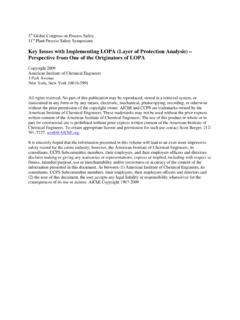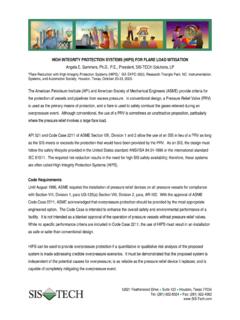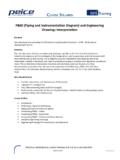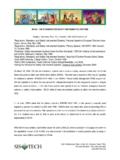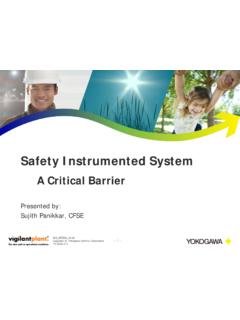Transcription of A review of Layers of Protection Analysis (LOPA) analyses ...
1 Executive Health and Safety A review of Layers of Protection Analysis (LOPA) analyses of overfill of fuel storage tanks Prepared by Health and Safety Laboratory for the Health and Safety Executive 2009 RR716 Research Report Executive Health and Safety A review of Layers of Protection Analysis (LOPA) analyses of overfill of fuel storage tanks Colin Chambers, Jill Wilday & Shane Turner Health and Safety Laboratory Harpur Hill Buxton Derbyshire SK17 9JN In response to the Buncefield incident, the Major Incident Investigation Board (MIIB) made recommendations to improve safety in the design and operation of fuel storage sites. Two of these recommendations were that loss of primary containment (tank overfill) should be prevented by a high integrity system, and that industry should agree to undertake a systematic assessment of safety integrity levels using commonly agreed methods.
2 The Buncefield Standards Task Group (BSTG), consisting of representatives from industry and the control of major accident hazards (COMAH) Competent Authority, also stated in its final report, Paragraph 16, Before protective systems are installed there is a need to determine the appropriate level of integrity that such systems are expected to achieve. The BSTG report suggests a layer of Protection Analysis (LOPA) study be used to provide a more consistent approach to safety integrity level (SIL) determination. Therefore, in response to the MIIB and BSTG recommendations this study aimed to identify common trends and instances of good practice and areas requiring discussion / improvement in the way in which LOPA studies were carried out by operators of sites that bulk store fuels such as petrol.
3 This study is part of ongoing work to stimulate discussion between concerned parties with the aim of contributing to the development of improved guidance. Further guidance can be found on the relevant HSE websites. This report and the work it describes were funded by the Health and Safety Executive (HSE). Its contents, including any opinions and/or conclusions expressed, are those of the authors alone and do not necessarily reflect HSE policy. HSE Books Crown copyright 2009 First published 2009 All rights reserved. No part of this publication may be reproduced, stored in a retrieval system, or transmitted in any form or by any means (electronic, mechanical, photocopying, recording or otherwise) without the prior written permission of the copyright owner.
4 Applications for reproduction should be made in writing to: Licensing Division, Her Majesty s Stationery Office, St Clements House, 2-16 Colegate, Norwich NR3 1BQ or by e-mail to ii ACKNOWLEDGEMENTS The authors would like to acknowledge the help and advice from HSL colleagues in the Risk Science Unit, who made useful contributions regarding the human factors aspects of this work. I would also like to thank all those in the Health and Safety Executive (HSE), including Control and Instrumentation specialist inspectors from the Hazardous Installations Directorate, who supplied example Layers of Protection Analysis (LOPA) assessments so that the work could proceed.
5 Iii iv CONTENTS 1 INTRODUCTION ..4 Study method ..5 Report 2 COMPANY A; LOPA ID 1 ..7 Risk tolerance Initiating events ..7 Conditional Protection General comments ..14 LOPA conclusions ..14 3 COMPANY B; LOPA ID 2 ..15 Risk tolerance Initiating events ..15 Conditional Protection General comments ..19 LOPA conclusions ..20 4 COMPANY C; LOPA ID 3 ..21 Risk tolerance Initiating events ..21 Conditional Protection General comments ..23 LOPA conclusions ..24 5 COMPANY D; LOPA ID 4 ..25 Risk tolerance Initiating events ..25 Conditional Protection General comments ..31 LOPA conclusions.
6 31 6 COMPANY E; LOPA ID Risk tolerance Initiating events ..33 v Conditional Protection General comments ..37 LOPA conclusions ..37 7 COMPANY F; LOPA ID LOPA Risk tolerance criteria ..39 Initiating events ..39 Conditional Protection General comments ..41 LOPA conclusions ..42 8 COMPANY G; LOPA ID 7 ..43 Risk tolerance Initiating events ..43 Conditional Protection General comments ..45 LOPA conclusions ..46 9 MAIN General Initiating events ..47 Conditional Protection Risk tolerance 10 APPENDIX A LOPA CASE DATA: SUMMARY OF CM, IE & IPL ..52 11 APPENDIX B LOPA CASE DATA: SUMMARY OF MITIGATED & UNMITIGATED CONSEQUENCE, TARGET SIL & SIL GAP.
7 55 12 13 GLOSSARY ..57 vi EXECUTIVE SUMMARY Background In response to the Buncefield incident, the Major Incident Investigation Board (MIIB) made recommendations to improve safety in the design and operation of fuel storage sites. Two of the MIIB recommendations for the design and operation of fuel storage systems were that loss of primary containment (tank overfill) should be prevented by a high integrity system, and that industry should agree to undertake a systematic assessment of safety integrity levels using commonly agreed methods. Shortly after the Buncefield incident, the Buncefield Standards Task Group (BSTG) was formed, consisting of representatives from the control of major accident hazards (COMAH) Competent Authority and industry.
8 Its aim was to translate the lessons from Buncefield into effective and practical guidance that industry could implement as rapidly as possible. As stated in the BSTG final report, Paragraph 16, Before protective systems are installed there is a need to determine the appropriate level of integrity that such systems are expected to achieve. The BSTG report suggests a layer of Protection Analysis (LOPA) study be used to provide a more consistent approach to safety integrity level (SIL1) assessment. The LOPA method has been adopted by industry, which has submitted LOPA studies for its fuel storage overfill prevention systems to the Health and Safety Executive (HSE) for assessment.
9 HSE would like to identify any common issues associated with industry s application of the LOPA method, which can then be fed back to industry. The Hazardous Installations Directorate (HID) of HSE therefore asked the Health and Safety Laboratory (HSL) to analyse a sample of LOPA studies submitted by operators of Buncefield-type COMAH sites that store flammable liquids such as petrol; seven of these LOPA studies are presented in this report. Objectives Assess a sample of LOPA studies submitted to HSE by operators of top tier COMAH sites that bulk store fuels such as petrol, whose loss of containment could result in a vapour cloud explosion (VCE); Outline common trends and instances of good practice and areas requiring discussion /improvement; Provide a report that will allow HSE to provide feedback to those who perform LOPA studies (dutyholders and consultants).
10 Publishing this Report to stimulate further discussion and improvements in LOPA and similar studies. 1 Where the failure of a process can result in a certain level of risk, suitable prevention measures that are able to control, protect or mitigate this level of risk, need to be implemented. In the process sector, conformance to BS EN 61511 enables the safety performance requirements for these risk reduction measures to be quantified by means of the Safety Integrity Level (SIL). The SIL, which is assigned to a safety integrity function (SIF), determines the rigour applied to the development and operation of the safety instrumented system (SIS) which implements the SIF.











